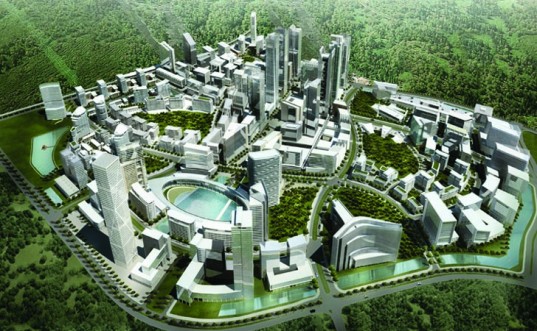
Photo: IskandarMalaysia.com.my
As COP 18 in Doha seems to have failed (as of writing) to reach a consensus on how to further climate change action for the future, Malaysia proves to be one developing country with a plan for internal action. The country has set ambitious emission reduction targets: by 2020 it has committed to cut it emission intensity by 40 percent form 2005 levels, as the city continues it economic drive to “developed” country status by 2020.
One specific design to achieve this goal is Iskandar Malaysia. It is the first “smart metropolis” or new green, energy efficient ecocity of Southeast Asia. Iskandar was founded on principles of social integration as well as low-carbon emissions to combat environmental challenges, thanks to leveraging a green economy and green technologies. Planners hope for the city to be a model for smart city planning as cities will increasingly be strained by rapid urbanization, and the associated environmental, social and economic needs.
By 2050, it is estimated that 6 billion of the 9 billion people on earth will live in urban areas. This is challenging on many levels. Assuming business as usual scenarios, over 70 percent of carbon emissions will relate to city requirements. Anticipated urban carbon emissions by 2030 is estimated to equal 36.5 billion metric tons, which represents more than double the urban emissions of 1990.
Iskandar will increase its use of renewable energy to provide for anticipated increased energy demand, including solar and biomass, as well as integrating energy efficiency and waste will be reused. Low-carbon emission buildings, or zero emission, construction will be dramatically increased. In addition, a new public and private vehicle “smart” transportation system will be implemented. The overarching goal will be to emit a volume of emissions lower than nature can naturally absorb and for its actions to be replicated by other cities and nations.
The city itself is located north of Singapore in Johor, Malaysia. It spans over 2,000 square kilometers or about 3 times the size of its southern neighbor. Iskandar, with a current population of 1.3 million, has been planned since its 2006 with the expectation to house 3 million residents by 2025. Demonstrating that green growth can be prosperous and successful, the city already accounts for about 70 percent of the total GDP of Johor. By 2025, Iskandar is estimated to attain a GDP of $193.3 billion and a per capita GDP of $31,100.
Prime Minister Datuk Seri Najib Razak said of the city: “Iskandar Malaysia [is] a smart city template – protecting the environment, promoting equitable development and addressing urban development challenges [through] the creation of smart, livable urban communities that will yield an improved quality of life for thousands of citizens, with safer, cleaner, healthier, more affordable and more vibrant neighborhoods, serviced by more efficient and accessible transportation systems – great destinations for businesses.”
Of course, this comes with a price and Iskandar will need to overcome hurdles to achieve its vision. Thus far, more than $30 billion has been pledged for the city, of which 37 percent will come from outside Malaysia. The city is actively pursuing additional foreign investment for added funding and to increase ecotourism.
Malaysia itself is experiencing a successful economic boom. The Prime Minister hopes Malaysia will reach ‘developed’ nation status by 2020 through sustainable development, which can be an example to other ‘developing’ nations. He understands the tough choices in pursuing the goal through environmentally responsible means—80 percent of government revenue comes from oil and gas. The nation’s anticipated development target by 2020 coincides with the scientific consensus that 2020 is the last year to globally be able to stay below 2 degrees Celsius (or 3.6 degrees Fahrenheit) limit of temperature rise from pre-industrial levels to avoid catastrophic climate change.
As mentioned earlier, the nation has very ambitious carbon reduction targets. It intends to reach those with a comprehensive plan partly through a solar program including a feed-in tariff, diversifying its economic sectors to increase low-carbon adaption and adapt energy efficiency. The Prime Minister thinks economic opportunities are prevalent mitigating climate change and he wants to capture the opportunity.
“We aim to meet this goal through a variety of measures (building upon its LED lighting and solar panel sectors), all of which increase growth, create new industries and jobs, (lead low-carbon economy of future) and boost prosperity,” the Prime Minister concluded. Through its solar panel manufacturing, LED lighting, and future industries, Malaysia can be viewed
Despite almost uniform calls from developing nations for developed nations to take action for their carbon emissions past and present, and to help provide finance and technology for developing nations to adapt, Mr. Razak feels Asian nations need to prepare to reduce their own emissions with more urgency. He says “doing nothing is no longer an option.”